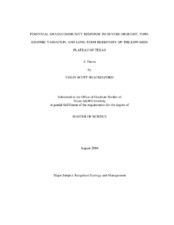| dc.contributor.advisor | Smeins, Fred | |
| dc.creator | Shackelford, Colin Scott | |
| dc.date.accessioned | 2005-11-01T15:47:47Z | |
| dc.date.available | 2005-11-01T15:47:47Z | |
| dc.date.created | 2004-08 | |
| dc.date.issued | 2005-11-01 | |
| dc.identifier.uri | https://hdl.handle.net/1969.1/2627 | |
| dc.description.abstract | Perennial grass vegetation dynamics of heavy grazing, moderate grazing and ungrazed treatments were analyzed during two extreme drought events: the drought of 1951 to 1956 and the drought events centered on the year 2000. Analysis of each drought event from weather records and Palmer Drought Severity Index values showed that the intensity, duration and pattern of each drought event were structurally unique. Grazing intensity was the primary driver of perennial grass species composition and community structure both during and between each drought event. Total basal area for each drought event was driven primarily by variation in precipitation pattern. Basal area per plant dynamics were significantly influenced by grazing intensity while plant density was driven by both precipitation and grazing intensity.
Topo-edaphic variation significantly influenced the persistence and distribution of perennial grass species during an extreme drought event centered on the year 2000. The presence of large or abundant surface rock features facilitated the survival of perennial grasses during this drought event by creating a positive soil microenvironment. Sites with large surface rock features acted as drought refugia for perennial grass populations. Sites with abundant surface rock features had 10 times greater perennial grass basal area and 5 times greater plant density than sites with few surface rock features. Grazing intensity was the primary driver of species composition and community structure within both refugia and non-refugia sites. Grazing intensity had no effect on perennial grass basal area. However, grazed treatments had two times greater perennial grass density than non-grazed treatments. Species response to grazing intensity and surface rock cover was individualistic. Grazing response groups (intolerant, intermediate, and tolerant) separated along a gradient of surface rock cover and grazing intensity. Abundant surface rock features act as refugia for perennial grasses by facilitating their persistence during extreme drought events on the Edwards Plateau. | en |
| dc.format.extent | 2073537 bytes | en |
| dc.format.medium | electronic | en |
| dc.format.mimetype | application/pdf | |
| dc.language.iso | en_US | |
| dc.publisher | Texas A&M University | |
| dc.subject | drought | en |
| dc.subject | perennial grass | en |
| dc.subject | herbivory | en |
| dc.subject | refugia | en |
| dc.title | Perennial grass community response to severe drought, topo-edaphic variation, and long-term herbivory on the Edwards Plateau of Texas | en |
| dc.type | Book | en |
| dc.type | Thesis | en |
| thesis.degree.department | Rangeland Ecology and Management | en |
| thesis.degree.discipline | Rangeland Ecology and Management | en |
| thesis.degree.grantor | Texas A&M University | en |
| thesis.degree.name | Master of Science | en |
| thesis.degree.level | Masters | en |
| dc.contributor.committeeMember | Taylor, Charles | |
| dc.contributor.committeeMember | White, Larry | |
| dc.contributor.committeeMember | Srinivasan, Raghavan | |
| dc.type.genre | Electronic Thesis | en |
| dc.type.material | text | en |
| dc.format.digitalOrigin | born digital | en |


